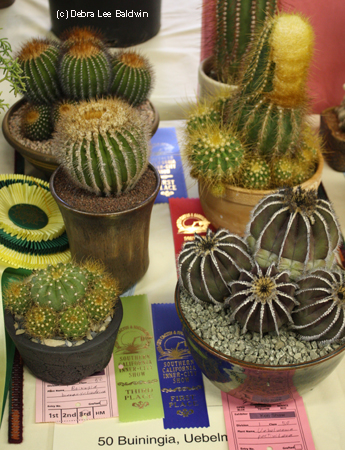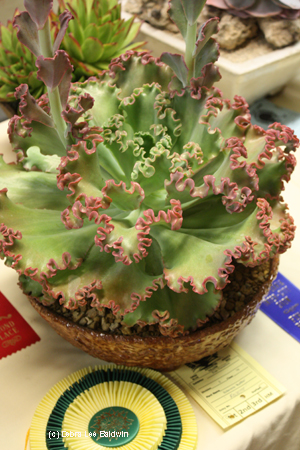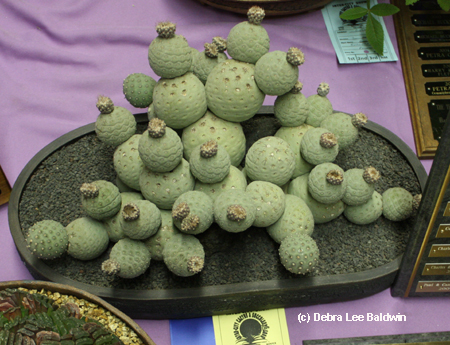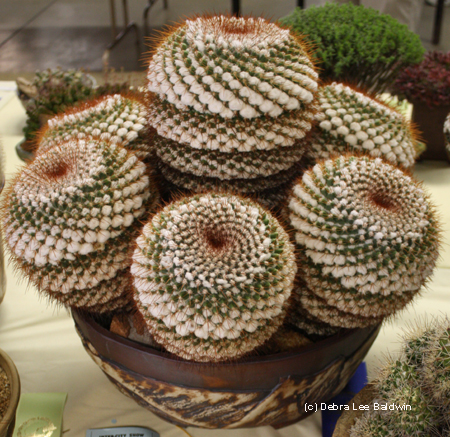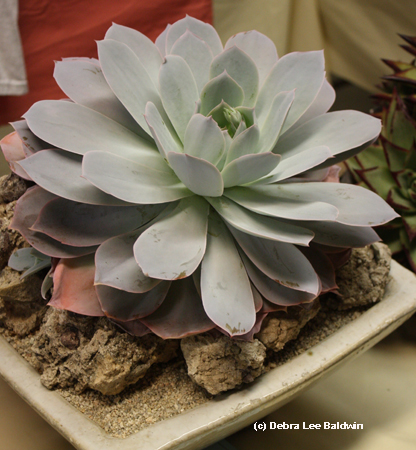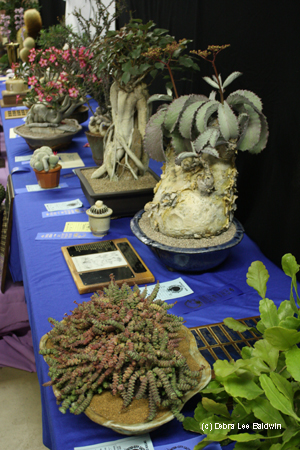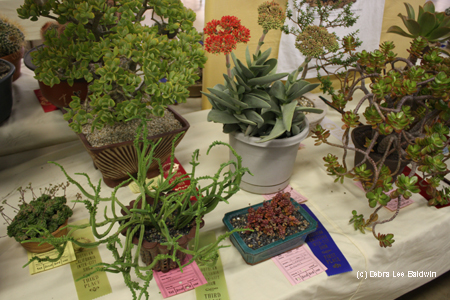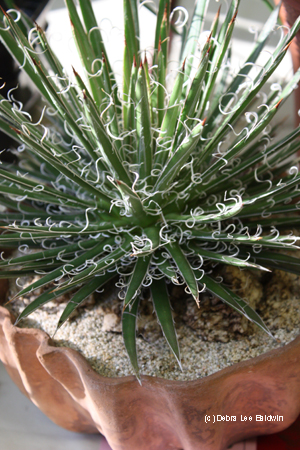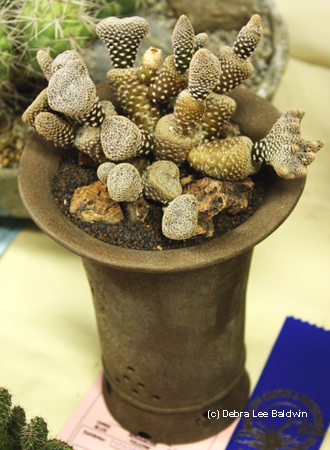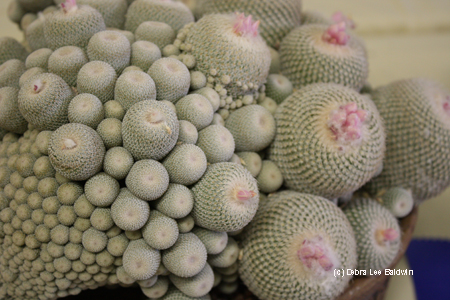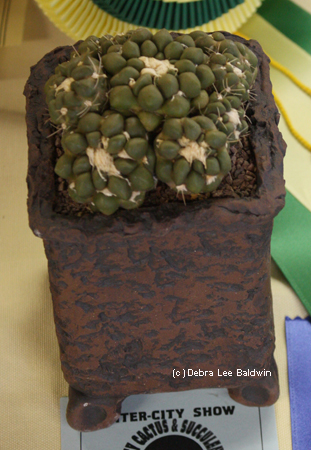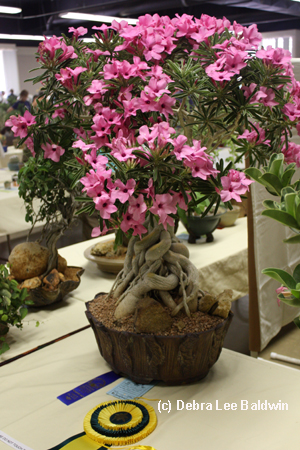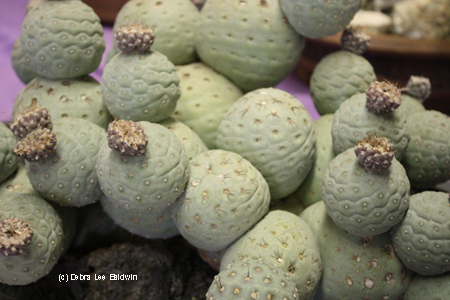The annual cactus and succulent show at the Los Angeles Arboretum is the largest in the world. It’s a 2-hour drive for me, but I wouldn’t miss it. When I see a plant I’ve never seen before or a perfect specimen of something I’m familiar with, I go slack-jawed and stare. And this year there were dozens.
…Like this soccer-ball-sized ruffled echeveria owned by Tom Vermilion. Cactus and Succulent Society of America president Laurel Woodley explained that each judge is given two big green-and-yellow ribbons for plants that they deem outstanding, yet did not get on the trophy table. “Judges are asked to make written comments on the back of the ribbon explaining why they feel the plant is exceptional,” Woodley said. “The awardees get to keep this ribbon of merit.”
This tephrocactus was on the trophy table. Isn’t nature amazing? If someone handed you 40 green clay balls, could you construct such an appealing, eye-catching arrangement?
The size and geometry of this cluster of Mammillaria canalensis wowed me. Check out the pot, too. Collectors often invest in one-of-a-kind, artist-designed pots in which to showcase their prize-winning plants.
Leaves of Echeveria ‘Cante’ are coated with a white powder that lends a silvery sheen. But such pulverulence rubs off easily, and there’s no replacing it—making it that much more difficult to keep the plant pristine. This plant is owned by Larry Grammer, an artist on staff at California Cactus Center in Pasadena. Larry beautifully staged the plant—meaning that pot, plant, rocks and topdressing combine to create a work of art.
Some trophy-winning plants were bonsais with elevated, sausagelike roots that resemble human limbs—a blog topic in itself. What do you think, should I do a GGW post on “Nude Roots”?
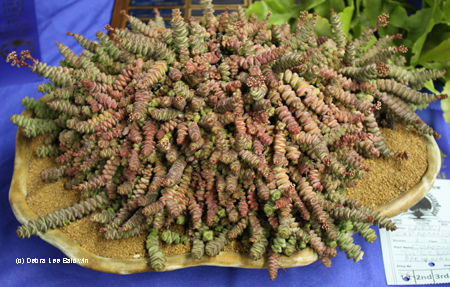
This stacked crassula also is owned by Larry Grammer, who told me he entered 70 plants in the show. Not surprisingly, Larry (though shy and unassuming) is a renowned celebrity among cactus and succulent enthusiasts.
Doubtless you’re familiar with jade plant (Crassula ovata). There are subspecies of it on the far right and upper left—plants that each won second-place (red) ribbons. The crassula in bloom is Crassula perfoliata var. falcata, commonly known as propeller plant. And the wavy-stemmed crassula in the foreground is Crassula muscosa, or watch-chain crassula. It’s a good one to use in undersea-themed succulent-scapes. But notice what earned a blue ribbon: a red-leaved crassula in a turquoise bonsai pot—a premier example of Crassula elegans.
The agave table alone is worth the price of admission. (The show is free, btw, but you have to pay to get into the Arboretum.) Diminutive Agave ‘Silver Princess’ is closely related to more common Agave ‘Victoria-Reginae’.
This is Agave multifilifera, owned by Hannah Nguyen. I met Hannah at the show, and she happily introduced me to a dozen or so of her prize-winning plants.
Hannah’s Puna clavarioides is a high-altitude cactus from Argentina. It’s native habitat is harsh—arid and consisting of barren rocks and sand. Consequently, the plant is highly sensitive to overwatering yet also tolerates temperatures well below freezing.
Hannah and I were enthralled by this crested cactus—an epithelantha native to the Mexico state of Chihuahua. It’s just coming into bloom.
You never know what will impress the judges. I wouldn’t have looked twice at this Cintia knizei if it hadn’t been surrounded with ribbons. I later found out it’s a very rare alpine cactus native to the high Bolivian Andes. The owner is another revered collector: Peter Walkowiak of San Diego. I show two of his prize-winning plants in my book, Succulent Container Gardens.
Here’s one of them, a bonsai’d adenium with elevated roots that I photographed at last year’s show. As you might tell by the flowers, adeniums are in the same family as plumerias and oleanders.
Of all the plants that captivated me, the tephrocactus was my favorite. I love its globular leaves, pale green color, patterned skin and sculptural form.
How about you? Did any of the plants I showed here make you swoon?
More info: The two-day event draws collectors and enthusiasts from all over the world and is held in mid-August. This was the 25th year. If you’re planning on going in 2011, it would be fun to meet in person (best way is to “friend” me on Facebook). Also, I’ll give my Designing with Succulents presentation to one of the main host clubs, the San Gabriel Valley Cactus & Succulent Society, on November 11, 2010 at 7:30 p.m. at the Los Angeles Arboretum. Please join us if you can!
My goal is to share the beauty of waterwise, easy-care succulents in gardens, containers and landscapes via blog posts, newsletters, public speaking and workshops, photos, videos, merchandise, and social media (Facebook and Pinterest). My books: Designing with Succulents, Succulent Container Gardens, and Succulents Simplified. www.debraleebaldwin.com

